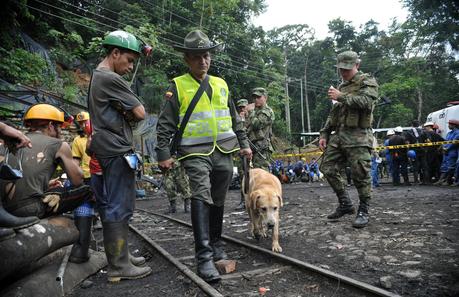 Two year-old Ginny–a beautiful, brindled-colored Dutch Shepherd living in Virginia–carries considerable weight on her slender shoulders as a four-legged pioneer in mine rescue.
Two year-old Ginny–a beautiful, brindled-colored Dutch Shepherd living in Virginia–carries considerable weight on her slender shoulders as a four-legged pioneer in mine rescue.
While friendly and sweet-natured to this reporter during a brief encounter at the 2012 National Search and Rescue Conference in Lake Tahoe, Nevada, Ginny is all business when it comes to doing her job as the world’s first mine search and rescue dog, trained to perform search and rescue in both underground and surface mines.
As her trainer Bill Dotson–president of Applied K9 Technologies and a nationally renowned expert in search and rescue, disaster and cadaver search dog training–explained at the conference, Ginny is the kind of dog “who won’t quit” when searching for missing or trapped miners.
She shares that trait with the heroic search-and-rescue dogs who, for months, combed through the rubble and debris of the World Trade Center for any human scent in the aftermath of the terrorist attacks on 9/11.
Her employer, Alpha Natural Resources, can confidently place the lives of its miners in Ginny’s paws. Trained to remain with the fallen and/or injured miner and keep barking to guide rescuers to the victim, Ginny’s voice is the “bark of hope,” as one employee recently observed.
The idea of training the world’s first and only mine rescue dog started with a very simple idea: What could continuous improvement bring to mine rescue? The answer was found through combining mine rescue technology with search and rescue skills.
By December 2010, a project plan proposal spelled out what K9 Search and Rescue would bring to the mining industry; how the dog would work within the parameters of traditional mine rescue; and what capability the dog would provide that Alpha’s mine rescue teams did not already possess.
After the plan was approved, the best dog, the best trainer, and the best champion and mentors for the plan were sought. Alpha’s Director of Continuous Improvement, Rick McAllister, and Randy McMillion, executive vice president for Alpha Safety, HR and the Running Right safety process, among others, would become the champions of an underground search, rescue and recovery K9 program.
The off-spring of two top-performing Royal Dutch police dogs, Ginny was selected from 44 puppies bred at the Logan Haus Kennels, a Greenbrier Valley, West Virginia, kennel, which supplies some of the nation’s highest performing dogs to the military, special operations, and law enforcement.
Dotson worked to turn Ginny’s natural instincts, such as hunting prey, into skills deployable for a search and rescue dog. The “hunt” was the search for a different type of “prey”, fallen, missing or buried miners.
McAllister became Ginny’s first handler. Her training regime included obedience training; search, find and alert training on the human scent; introduction and familiarity with mine rescue teams; and getting used to underground and surface coal mines, heavy mining equipment, rubble piles, and the sounds and traffic associated with mining operations.
Like the search-and-rescue dogs used in disasters, Ginny had to be able to walk on any surface, scramble without hesitation over any object, find victims under an avalanche of debris in dangerous conditions, and, unlike her K9 counterparts, be able to do it all in complete darkness.
Ginny wears a portable gas detector simulator and listens for the alarm it sounds when she encounters dangerous gases or poor quality air. She will react to the sound and retreat immediately, warning mine rescuers of the potentially explosive air conditions ahead.
The dog’s protective vest shields her from punctures and other possible wounds from debris on the ground or falling rocks. Ginny wears portable lamps and an infrared camera which transmits visual information back to her handler and the rescue team.
Ginny is used to wearing safety goggles, and also will allow a rescue hood to be placed over her head during an emergency evacuation.
In an interview with Mineweb, McAllister said he trained with mine rescue teams not only to determine the best roles for the handler and his dog, but also to ease rescuers’ fears that he and Ginny were going to be little more than another two beings for rescuers to worry about while searching underground.
Meanwhile, the Mine Safety and Health Administration is working with Alpha on a draft protocol regarding technical equipment and procedures for Ginny during a mine emergency.
As the world’s first and only mine rescue dog, Ginny has become an ambassador for Alpha, the largest U.S. metallurgical coal miner, and is now being introduced to the general public, as well as mining industry-related groups. Recently, Ginny appeared at conventions, a state mine rescue contest, and at local schools.
She even has a coloring book on her exploits aimed at youngsters.
